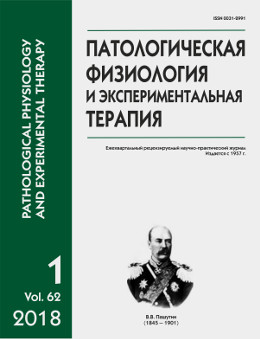Features of the effect of heparinoid from the pion together with arginine on the dissolution of venous thrombi in rats
Abstract
The purpose of the investigation was to study the effectiveness of combined use heparinoid from the Paeonia lactiflora, has anticoagulant and fibrinolytic effects, and arginine, improving blood flow properties, processes, fibrin and thrombosis caused by the introduction of thromboplastin. Methods. The experiments were performed on male rats Wistar (n=36) weighing 200-220 g. the processes of fibrinformation with subsequent thrombosis caused by intravenous administration of 0,4 ml of 1% bovine thromboplastin (model of thrombosis – MT). To study the effectiveness of combined subcutaneous administration of the preparations was determined minimal fibrindepolymerization and anticoagulant activity of each drug separately. 30 minutes before the mixture heparinoid with arginine (ratio 1:4 by weight) was introduced intravenously thromboplastin. Served as control animals that received saline in the same amount and under similar conditions of experience. Results. Established in vitro that the drug, including heparinoid from the root Paeonia molochnocvetkovogo and arginine with weight 1:4, possessed of anticoagulant and own fibrindepolymerizazion activity. When a skin of this drug in minimal doses (0.05 mg per 200 g of body weight) in rats increased blood anticoagulant, total, non-enzymatic and enzymatic fibrinolytic activity and decreased to normal values concentration fibrinogen. On model rats with tromboformation, called the introduction of tissue thromboplastin, shows antitrombotic and thrombolytic effects of the investigational drug. For the first time found that the use of this drug through the 30 minutes after the start of thrombosis in rats prevented the development processes of thrombosis or even contributed to the dissolution of the fresh produced fibrin clots. Conclusion. The combined use of heparinoid peony with arginine in the minimal active doses, increases the depolymerization of fibrin and prevents the process of thrombosis. The study can serve as an experimental justification for the use of drugs for thrombotic complications for the purpose of favorable influence on the dissolution of fresh just formed blood clots.
Downloads
References
2. De AsevedoT.C., Bezerra M.E., Santos М.G. , Souza L.A., Marques C.T., Benevides Н.М., Leute E.L. Heparinoids algal and their anticoagulant, hemorrhagic activities and platelet aggregation. Biomed Pharmacother. 2009; 63(7): 477-83.
3. Krichevsky L.A. А low molecular weight heparins in the modern system of control of blood clotting. Anestesiologiya.and reanimatologiya. Meditsinskaya reabilitatsiya. 2015; 16(117): 42-8. (in Russian)
4. Kristanov N.A., Safonova M.Yu., Bolotova V.S., Pavlova E.D., Sakanyan E.J. Prospects for the use of plant polysaccharides as therapeutic and prophylactic tools. Vestnik VGU, seriya Biologiya, Khimiya, Farmatsiya. 2005; 1: 212-21. (in Russian)
5. Mirmiran Р., Bahadoran Z.G., Gaseu А., Asisi F. The Association of Dietary l-Arginine Intake and Serum Nitric Oxide Metabolites in Adults: A Population-Based Study. Nutrients. 2016; 8 (5).
6. Trashkov A.P., Kovalenko A.L., Vasil'ev A.G., Valeev V.V. L-arginine as dietary supplement for improving microvascular function. Pathophysiological and clinical aspects of using L-arginine in cardiology and and angiology. Angiol Sosud Khir. 2016; 22 (3): 9–15.
7. Arslan R., Bektas N., Bor Z., Sener E. Evaluation of the antithrombotic effects of Crataegus monogyna and Crataegus davisii in the carrageenan-induced tail thrombosis model. Pharm Biol. 2015; 53(2): 275-9.
8. Colliec-Jouault S., Bavington C., Delbarre-Ladrat C. Heparin-like entities from marine organisms. Handb. Exp. Pharmacol. 2012; 207: 423-49.
9. Sogut O., Erdogan M.O., Kose R.., Boleken M.E., Kaya H., Gokdemir M.T., Ozgonul A., Iynen I., Albayrak L., Dokuzoglu M.A. Hemostatic efficacy of a traditional medicinal plant extract (Ankaferd Blood Stopper) in bleeding control. Clin Appl Thromb Hemost. 2015; 21(4): 348-53.
10. Wu M., Xu L., Zhao L., Xiao C., Gao N., Luo L., Yang L., Li Z., Chen L., Zhao J. Structural analysis and anticoagulant activities of the novel sulfated fucan possessing a regular well-defined repeating unit from sea cucumber. Mar. Drugs. 2015; 13 (4): 2063–84.
11. Xiao C., Lian W., Zhou L., Gao N., Xu L., Chen J., Wu M., Peng W., Zhao J. Interactions between depolymerized fucosylated glycosaminoglycan and coagulation proteases or inhibitors. Thromb Res. 2016; 146: 59–68.
12. Zhang S.B. In vitro antithrombotic activities of peanut protein hydrolysates. J.Food Chem. 2016; 202: 1–8.
13. Nsimba M.M., Yamamoto C., Lami J.N., Hayakawa Y., Kaji T. Effect of a Congolese herbal medicine used in sickle cell anemia on the expression of plasminogen activators in human coronary aortic endothelial cells culture. J. Ethnopharmacol. 2013; 146(2): 594–9.
14. Lyapina M.G., Uspenskaya M.S., Maistrenko, E.S. On the mechanism of the anticoagulant action of the extract from the roots of Paeonia lactiflora. Mezhdunarodniy Zhurnal Prikladnykh I Fundamentalnykh Issledovaniy. 2016; 11(6): 1091-3. (in Russian)
15. Lyapina L.A., Grigorieva M.E., Obergan T.Yu., Shubina T.A. Theoretical and practical issues of studying the functional state of the anticoagulation system of blood [Teoreticheskoe i prakticheskoe issledovanie funksionalnogo sostoyanya protivosvertyvauschey sistemy krovi]. Moscow, Advansed Solutions; 2012. (in Russian)






